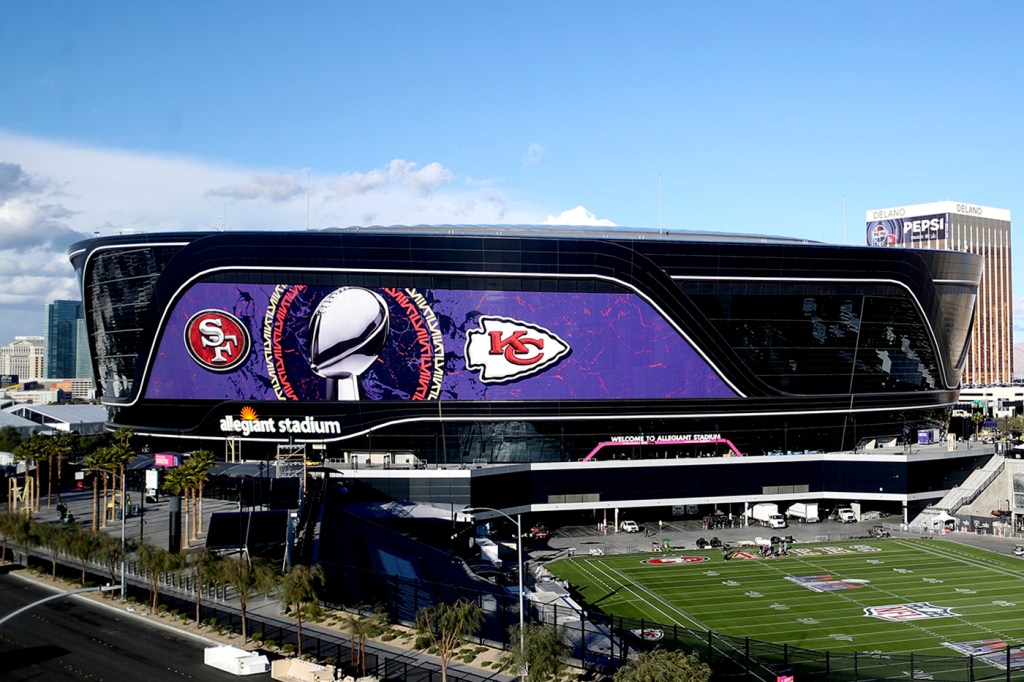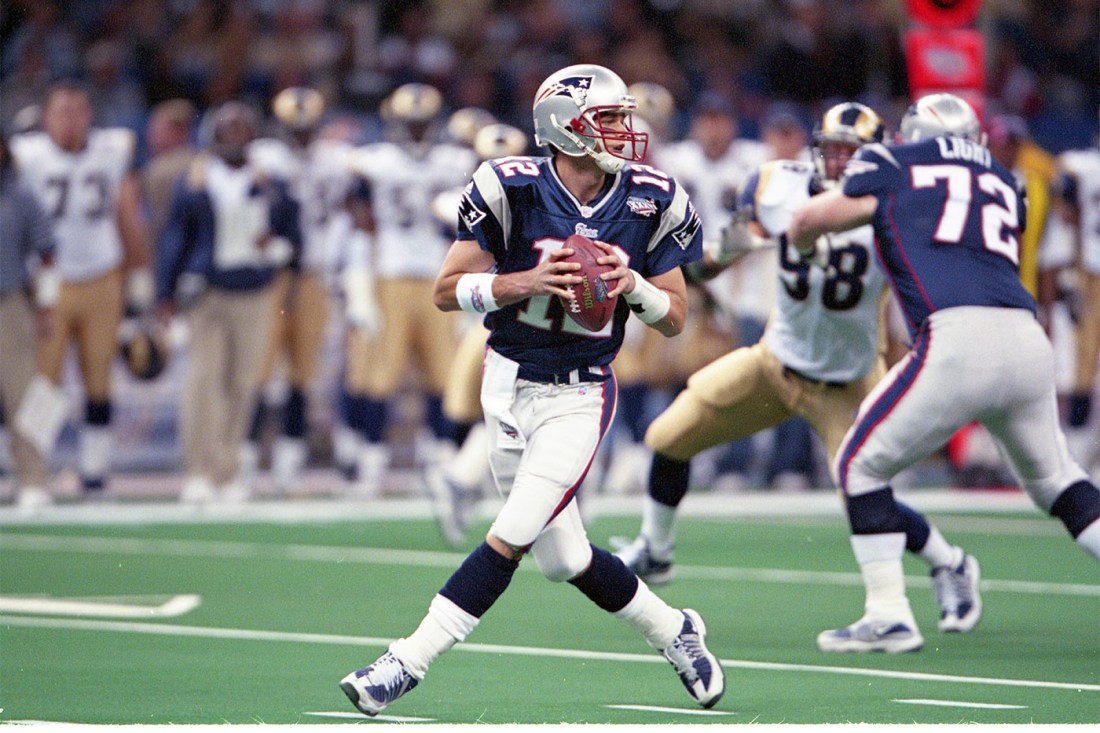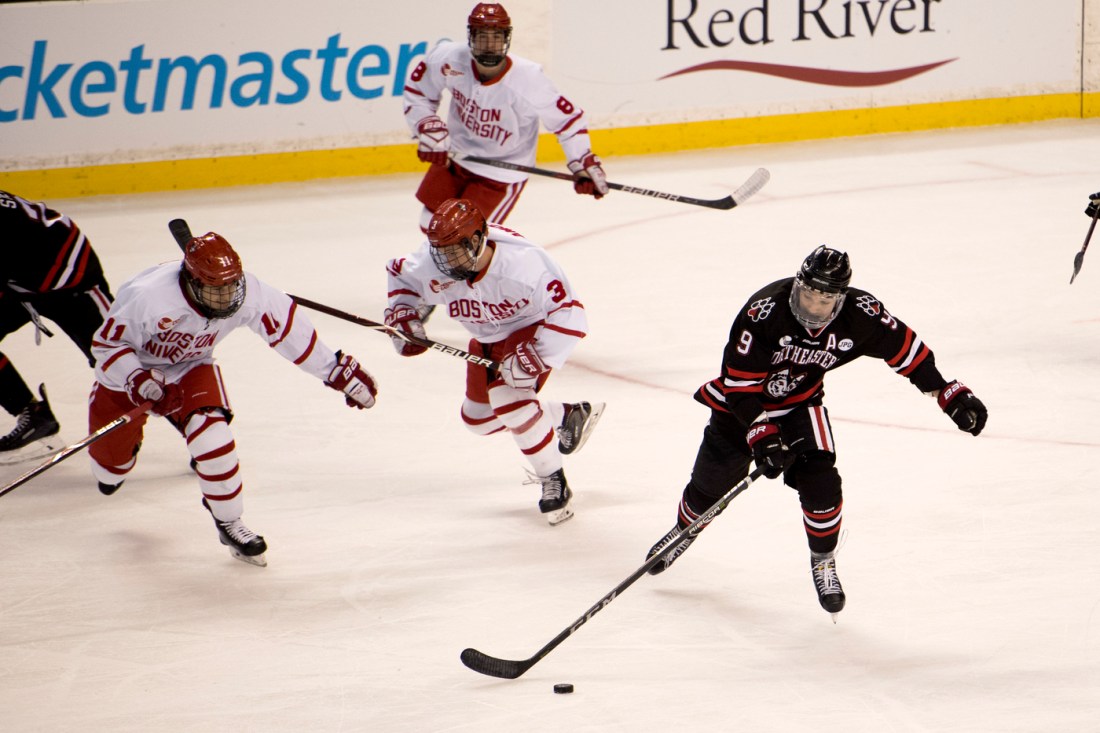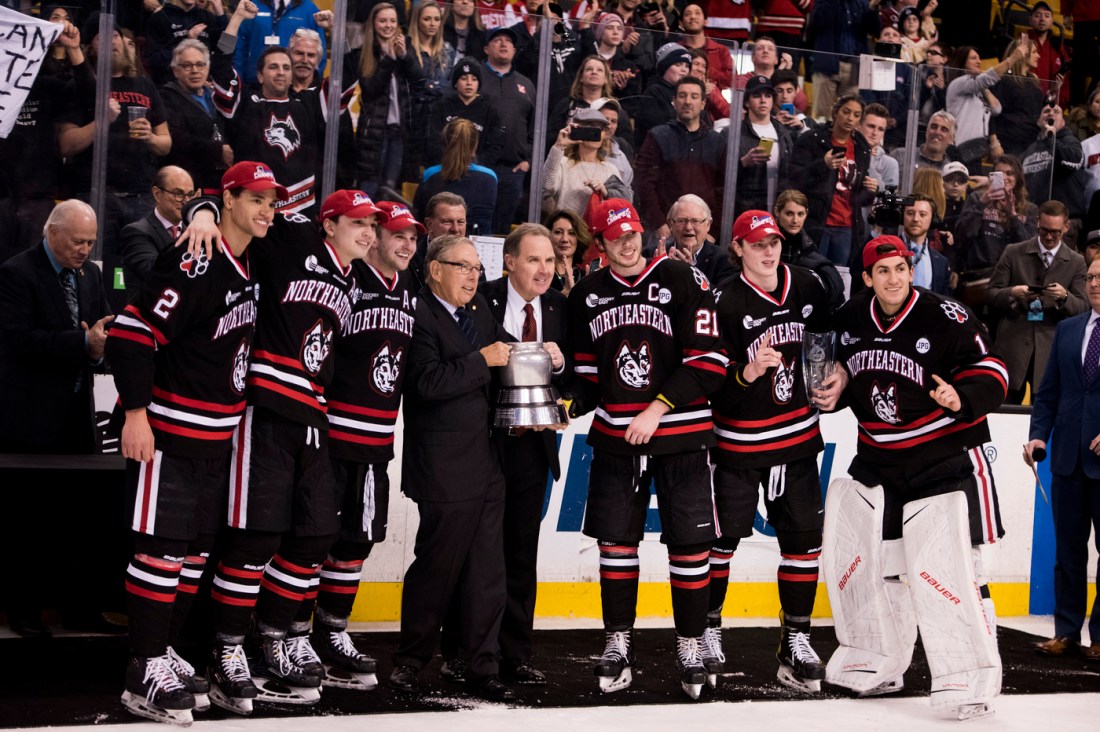Published on
What the Super Bowl, Beanpot and other sporting events teach us about coping with pressure
The fight-or-flight response is built into human evolution, flooding the body with adrenaline and other stress hormones that can result in rapid heart and breathing rates, trembling hands and dilated pupils — all involuntary physical responses to perceived dangers.

Some 65,000 fans attended the Super Bowl on Sunday in Las Vegas, where the least expensive ticket was going for $7,000. Well over 100 million people watched on TV or online. More than $20 billion was wagered on the game.
Taylor Swift even showed up.
Now imagine the anxiety felt by each player of the Kansas City Chiefs and the San Francisco 49ers as they approached the biggest sporting event in the country.
How did they respond to the pressure, the anxiety, the expectations?
“We talk in my class about how the fight-or-flight response kicks in at moments when we’re not actually in danger,” says Laura Dudley, an associate clinical professor who directs the minor in mindfulness studies at Northeastern University.”
It’s the same whether you’re a pro athlete or college student, she says.
“Sometimes that response can kick in when we are about to give a presentation in class or we’re about to have a difficult conversation with another person,” Dudley says. “So we all know what that feels like. My palms are sweaty and my heart’s racing — why are all these things happening? There’s no bear standing in front of me. I’m not being chased by some scary animal.”
Northeastern hockey players can definitely relate to the NFL stars. Last month the Huskies won their second straight Women’s Beanpot in an historic final at TD Garden that was attended by 10,633, a record for women’s hockey in New England.
On Monday, the Northeastern men completed the tourney sweep when they defeated Boston University in the championship game of the 71st Beanpot at soldout TD Garden. The ticket resale market wasn’t nearly as expensive as the Super Bowl, but the emotions triggered by the greatest tradition in college hockey are similar.
“There’s some nerves, some excitement, some jitters,” says Alex Campbell, a senior forward who co-leads the Northeastern men’s hockey team with 15 goals this season. “We know that it’s not just us — on the other team they’re feeling the same way.”

The bigger the sporting event, the more that audiences care — drawn in no small part to see how the players respond to the pressure. For better or for worse.
“I think a lot of it has to do with preparation,” says Campbell, who scored the opening goal in his Beanpot debut, a 3-2 overtime win over Harvard that advanced Northeastern to its sixth straight Beanpot final. “If you’ve put in the time — whether it’s sleep, nutrition, extra ice sessions — that kind of thing builds your confidence so you know that you’ve done it so many times before. It’s building those baseline habits so that when the opportunity comes you know you’re ready for it.”
But is it that simple? The fight-or-flight response is built into human evolution, flooding the body with adrenaline and other stress hormones that can result in rapid heart and breathing rates (meant to provide extra energy and oxygen), trembling hands (muscles tense naturally in anticipation of action) and dilated pupils (enabling better vision) — all involuntary physical responses to perceived dangers.
It turns out that the biggest sporting events generate more than large audiences and revenues. They also serve as large-scale classrooms, helping players and fans learn how to perform at their best when it matters the most.
The five-second rule
“A lot of this ties into performance anxiety, and it’s something that every athlete has,” says Grayson Kimball, a Northeastern lecturer who focuses on sport and performance psychology. “You could look at a guy like Tom Brady and say, ‘He’s never gotten nervous before Super Bowls.’ But I’m pretty sure Tom Brady got nervous before Super Bowls.”
Brady, who quarterbacked the New England Patriots and Tampa Bay Buccaneers to an NFL-record seven championships, was a prototype for looking calm under pressure.
“So the question is, do you know how to manage that performance anxiety?” Kimball says. “Do you control it? Or do you allow it to control you?”
Kimball has been a mental conditioning coach for more than 20 years. Half of his clients are athletes; the other half are executives, doctors and other professionals who have nothing to do with sports. People of those two worlds share one thing in common, he says: They can choose between investing in a positive or a negative mindset.
“For the athlete that tries to achieve success, they go into the game with a very specific game-plan mindset of ‘I’m going to do this to make that happen,’” Kimball says. “That’s the achievement mindset.
“The avoidance mindset is: ‘As long as I don’t jump offsides, I’ll be OK. … As long as I don’t get burned on a play, I should be fine.’ The problem there is the athlete is hoping all of these things don’t happen — rather than having the mindset of, ‘I’m going to go out there and do this or that.’
“That’s the real difference between athletes who can manage these performance anxieties, as opposed to the athletes who end up getting overwhelmed by it.”
Experience in the big moments can help so long as it is constructive. Kimball shares an anecdote involving one of Brady’s star receivers, Julian Edelman, who once gave an interview revealing that he and his therapist had come up with a “five-second rule.”
“He said after every play, ‘If I make a great catch, or I drop the ball or run the wrong route, I have five seconds to think about what went well and how to repeat it, or what went wrong and how to fix it,’” Kimball says. “He said by learning how to do that he was always in the moment. He never got too high and never got too low, regardless of the pressure.
“How quickly can these players shift when they do make a mistake? Do they have little strategies where they can shift from the negative mindset back to the positive mindset?”
To that end Kimball suggests that his clients write down three words that describe themselves when they’re performing at their best.
“If it’s a football player, maybe it’s ‘aggressive, quick, positive’ — those are your trigger words,” Kimball says. “Those three words are all you should be thinking about when you go out to play. Because if you start thinking about, ‘What if I drop this ball’ or ‘We’re up by two touchdowns, we’re going to win the game’ then you are so far out of the moment.
“So think about the three things that you can control. Am I aggressive? Am I quick? Am I positive? Because I control those three things. And if I’m not playing my best, it’s not because I stink or I’m not good; it’s because I’m not doing those three things.”
An enduring lesson can be drawn from Brady’s postgame interviews. He tended to focus on things that he and his teammates could control — and he dismissed everything else.
“When this team won, it was: ‘We executed the things that we worked on in practice,’” Kimball says. “When his team lost it was: ‘We didn’t execute the things that we worked on in practice, we need to be better.’ He never attributed successes or failures to external or non-controllable factors.
Featured Posts
“If you listen to other players you may hear, ‘They just played better than us.’ But that would not be the Tom Brady response. He would say, ‘We didn’t play as well as we should have.’”
‘No pressure, no rings’
“I wish I could have been more relaxed,” says Jim Madigan, Northeastern’s director of athletics, as he looks back on his career as a hockey player with the Huskies. “I wish I could have learned to compartmentalize … to have the patience to wait for the moment and then, when it comes, to enjoy it.”
But Madigan played in the 1980s when athletes were criticized or ridiculed for addressing their feelings. To focus on the mental side of the sport was to invite accusations of being soft and lacking toughness.
“It was, ‘Suck it up!’ ‘Work hard!’ ‘Head down and full speed ahead!’” says Madigan, who won two Beanpot titles as a player. “There was nothing about mental preparation. It was all about physical preparation and resiliency and resolve. ‘Just battle through it, fight through it, you’ll be OK.’ That was always the narrative around your preparation.”
Four decades later it’s as though that world has been toppled right-side up.
“We’ve become much smarter in how we prepare — physically, mentally, nutritionally, emotionally,” Madigan says. “Our athletes are more prepared and more ready to face the challenges because there’s more education around it and there’s more teaching about it. And that happens all year long.”
Emotional preparation is especially important, Madigan believes.
“How can you maintain a balance to prepare emotionally for your next year?” Madigan says. “Or for the big game?”
Madigan gained appreciation for the emotional aspect after he became Northeastern’s men’s hockey coach in 2011. With the help of assistant Jerry Keefe and others, he rebuilt the program into a winner that reached the NCAA tournament in 2016. In the meantime the pressure to win the Beanpot kept growing. By 2018 it had been 30 years since Northeastern’s last title.

The Huskies were led by three elder stars that season. Hobey Baker Award winner Adam Gaudette (30 goals and a nation-best 60 points) inspired teammates with fiery emotion, while fellow first-team All-American Dylan Sikura (54 points) and team captain Nolan Stevens (42) offered a calming sense of confidence as they approached the 2018 Beanpot championship game against BU.
“You’re trying to break a 30-year jinx and people are always saying, ‘Hey, when are you going to win?’ and they’re talking about the Beanpot in December when we still have two months to go,” Madigan says. “I put it up [in the locker room], ‘Embrace the pressure.’ Meaning I wanted them to enjoy it, it’s good to have pressure, it means you’re in the right spot.
“And then Sikura put something up on the board as we’re getting ready: ‘No pressure, no rings.’ So if there’s no pressure, there’s going to be no rings. It was just to make people feel at ease.”
It worked. The Huskies recovered from an early deficit to earn a 5-2 victory that instantly flipped the narrative: They’ve played in every men’s Beanpot final since that memorable night, winning five of them.
“The game is played 90 percent in the head,” says Madigan, who became athletic director in 2021 and elevated Keefe to head hockey coach. “Once you’re prepared [physically] it’s the will to compete, the will to succeed, the will to do the right thing. And then there’s the emotional component — there are peaks and valleys to every game, and you’ve got to be emotionally balanced and emotionally intelligent to withstand those.”
‘The reward is to play in these games’
Art Kramer, a professor of psychology and director of the Center for Cognitive and Brain Health at Northeastern, has done two studies over the past 15 years showing that trained athletes tend to be superior in terms of attention, memory and other cognitive abilities.
“They tended to excel in many aspects of attention — the ability to pay attention and focus on things that are important, and to discount things that are less important — as well as memory,” Kramer says. The latter talent helps quarterbacks and players in other team sports know where to pass and who to pass to, based on the capabilities of their teammates.
Do people shine as athletes because they were born with those attributes? Or were the traits developed by way of training? Kramer has seen estimates that rate it around 50-50 between learned behavior and genetics.
“Nobody really knows because we can’t do the right studies,” says Kramer, noting that it would require separating children and training them from a young age.
Regardless of why they succeed, the best athletes know that success is going to result in pressure.
If you’ve put in the time — whether it’s sleep, nutrition, extra ice sessions — that kind of thing builds your confidence so you know that you’ve done it so many times before. It’s building those baseline habits so that when the opportunity comes you know you’re ready for it.
Alex Campbell, a senior forward for Northeastern men’s hockey team
Training in mindfulness has helped athletes learn how to tune out external distractions like booing fans or a yelling coach, says Laura Dudley.
“But then also we could talk about the internal distractions, and some might argue that actually can be more interfering,” Dudley says. “Things like your own habitual thought patterns, whether it’s the negative things that you say to yourself in the moment, like, ‘I can’t do this’ or ‘I shouldn’t be doing this’ or ‘I’m not good at this’ or ‘I’m going to fail.’ All of those kinds of stories that we tell ourselves can certainly be a hindrance to performing well under pressure, whether it’s in the Super Bowl or the Beanpot or whatever.”
Meditation and other mindfulness tools can help players recognize their own symptoms of stress. Breath control can help relieve restrictive feelings.
“It’s a calming, grounding kind of exercise, and you may find that you also start to do it naturally outside of your meditation, whether it’s in a sporting event or in a class or during a difficult conversation,” Dudley says. “That’s what meditation is. Meditation is not about having this beautiful, peaceful, five-minute break in your day. Because if you then leave your meditation and you go off and you’re resentful and angry and terrible at your sport — what was the point of that meditation?
“Meditation is a practice where we hope to get the benefits when we’re not in our meditation. So whatever you’re working on in your meditation, you may find the benefits of it when you are just going about your day.”

Another way for players to deal with pressure is to change the point of view, says Dudley. Instead of dwelling on what your performance means for you, think about how it might help your teammates.
“Focus on how somebody else may benefit from whatever it is you’re doing and it totally changes the experience,” Dudley says. “You’re no longer as nervous because your intention is now about other people instead of about yourself.
“When you take the focus off of yourself and onto somebody else, it just totally transforms the experience. And you do better.”
Players themselves focus on the importance of preparation in all kinds of ways. When Aerin Frankel was the two-time national goaltender of the year while leading Northeastern to back-to-back NCAA Frozen Fours, she readied herself for games by making sure she slept well for several days, ate healthy food and — especially on game day — avoided her phone. “Using technology tires out my eyes a little bit,” she said in 2022.
“I would say I don’t get super nervous,” Frankel said. “Obviously the bigger games come with some nerves. But I think I’ve adjusted to playing at this level and over the years I’ve had less and less nerves as I’ve become more and more comfortable playing.”
Knowing that she had done everything in her power to prepare contributed to her peace of mind. Strengthened by that confidence, she would spend the last couple of hours before the games relaxing with her teammates, juggling a soccer ball with them in an arena hallway and having fun.
After the hard work is done, there will be no success in the game unless the players are enjoying themselves. The ultimate goal is to find fulfillment and joy in the sport, players will tell you. As it is in life.
“All year you work to get ready,” Keefe says. “You put the work in and the reward is to go out and play in these types of games.”
Campbell believed the nerves he felt leading up to the championship final helped drive him to his best performance.
“Everyone loves feeling those feelings,” Campbell says. “I think that’s part of the fun.”
Ian Thomsen is a Northeastern Global News features writer. Email him at i.thomsen@northeastern.edu. Follow him on X/Twitter @IanatNU.











